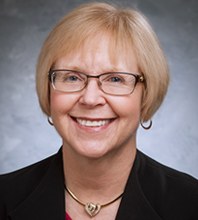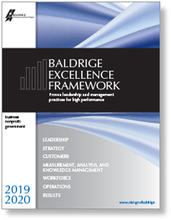Blogrige
The Official Baldrige Blog

2020 Judges Panel Blog Series
Each year we interview the newest members of the Judges’ Panel of the Malcolm Baldrige National Quality Award to share their individual insights and perspectives on the award process, their experiences, and the Baldrige framework and approach to organizational improvement in general.
The primary role of the Judges’ Panel is to ensure the integrity of the Baldrige Award selection process. Based on a review of results of examiners’ scoring of written applications (the Independent and Consensus Review processes), judges vote on which applicants merit Site Visit Review (the third and final examination stage) to verify and clarify their performance in all seven Criteria categories of the Baldrige Excellence Framework. The judges also review reports from site visit to recommend to the U.S. Secretary of Commerce which organizations to name as U.S. role models—Baldrige Award recipients. No judge participates in any discussion of an organization for which he/she has a real or perceived conflict of interest. Judges serve for a period of three years.
Meet Baldrige Judge Patricia Skriba

Patricia (“Pattie”) Skriba
Vice President–Business Excellence (Retired)
Advocate Good Samaritan Hospital
Illinois
What experiences led you to the role of Baldrige judge?
In 2006, Dave Fox, president of Advocate Good Samaritan Hospital (GSAM), asked me to lead the Baldrige journey at GSAM. It was a steep learning curve because I and my executive team colleagues knew nothing about the Baldrige framework! I became a Baldrige examiner, worked with GSAM leaders to design systems and deploy them, attended the Quest for Excellence® Conference annually starting in 2007, partnered with subject-matter experts in the “field of Baldrige,” benchmarked Baldrige Award recipients, and wrote our Baldrige Award application in 2010. [Advocate Good Samaritan received the Baldrige Award in 2010.]
Since then, I have served as chief judge for the Illinois (Baldrige-based award) program (ILPEX), have extensively shared GSAM’s story with organizations and other state (Baldrige-based award) programs, and frequently have taught the “Intro to Baldrige” and concurrent sessions at the annual Quest conferences. I have also had the privilege of engaging with the Baldrige Executive Fellows Program, both speaking at sessions and hosting the Baldrige Fellows at GSAM. Being an MBNQA judge does not mean I have arrived, however: I continue to learn!
How do you see the Baldrige Excellence Framework as valuable to organizations in your sector/industry?
It has been said that “organizations are perfectly designed to get the results they get!” The bottom line is that organizations are composed of a portfolio of systems and processes. How well those are defined, deployed, and integrated truly determines results. Dr. W. Edwards Deming was an advocate to think in terms of results generated by systems within which we all work. His teachings build on a theory of variation and the need to formally design and them improve our systems to narrow variation and, ultimately, get better results.
This is the wisdom of the Baldrige framework. It guides us to know which of an organization’s systems/processes/approaches are needed to achieve high performance and then gives us the ADLI [Approach, Deployment, Learning, Integration] evaluation approach to help each approach become mature. Health care is one of the most complex of all industries; we need to be effective and efficient. The systems and approaches required in the Baldrige framework are a blueprint for high reliability across all aspects of any organization.
As a judge, what are your hopes for the 2020 judging process? For instance, is there anything you’d like to help applicants and potential Baldrige Award applicants understand about the process?
Not surprisingly, the judging of Baldrige Award applicants is a defined process that undergoes cycles of improvement annually; it is critical that the award applicants, examiners, and other stakeholders know and trust in this. The entire award process is accountable to the Board of Overseers and, ultimately, NIST and the Secretary of Commerce. In my first year, I saw the how the award process reflects the Baldrige framework’s core values, particularly, ethics and transparency, management by fact, valuing people, and delivering value and results. I have experienced the Judges’ Panel to be an outstanding group of cross-sector professionals who have a passion for excellence and invest their time and energy in supporting [Baldrige Award] applicants and contributing to the sustainability of the Baldrige enterprise.
What encouragement/advice would you give Baldrige examiners for their work in evaluating organizations as part of the Baldrige Award process?
It is critical that Baldrige examiners realize that the judges rely heavily on their assessment and work. The judges spend hours studying the consensus notes/scores, the preliminary site visit feedback report, changes in scoring and strengths/OFIs [opportunities for improvement], and the rationale for scoring. The quality and thoroughness of the “handoff” of this information to the judges are essential. The panel then holds calls with each team lead, asking questions about the team’s observations and thinking.
It is critical to an effective judging process to have examiners who understand the Criteria for Performance Excellence [part of the Baldrige framework], are able to think critically, are skilled at examining an applicant, and are guided by a highly competent team lead. I am grateful for the time and expertise that our examiners, team leads, and Baldrige staff invest annually. They are the one of the Baldrige program’s strategic advantages! My challenge to the 2020 Board of Examiners is twofold: first, know how valuable you are to this program; and second, continue to learn and build your individual and collective competencies.
Judges Panel Blog Series: Previous Blogs
Allison Carter (Panel Chair)
Glenn Crotty
Christopher Laxton
Kevin McManus
Brigitta Mueller
Bruce Requa
JoAnn Sternke

Baldrige Excellence Framework
The Baldrige Excellence Framework has empowered organizations to accomplish their missions, improve results, and become more competitive. It includes the Criteria for Performance Excellence, core values and concepts, and guidelines for evaluating your processes and results.
Purchase your copy today!
Available versions: Business/Nonprofit, Education, and Health Care





